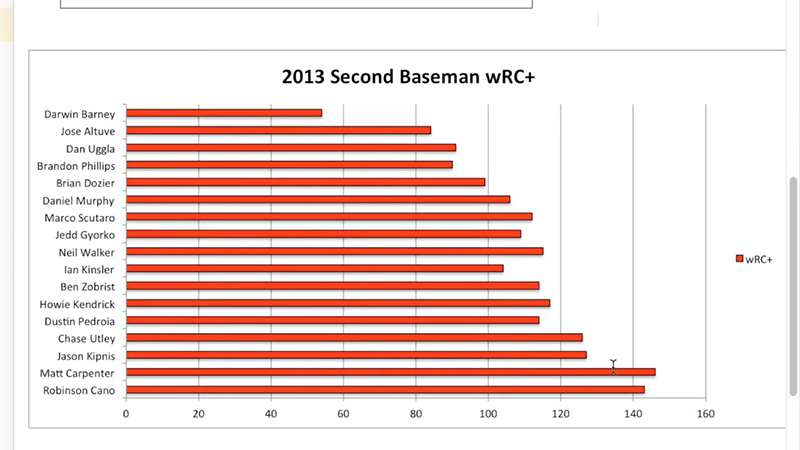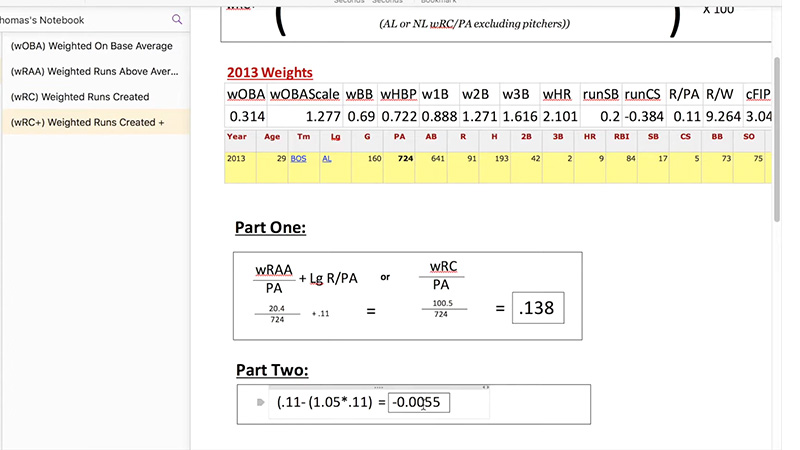Among all the different ways to evaluate the players’ achievement, WRC+ is the most advanced and effective one. But understanding the formula of this statistic and learning how to make the calculation sometimes seem pretty difficult.
And when a beginner encounters such a system for the first time, he just asks what weight runs created Plus (WRC+).
Well, to answer it in a single sentence, I would say that WRC+ is a powerful tool for measuring a player’s offensive contributions while adjusting for park factors and league-wide scoring levels. It is expressed as a percentage, with 100 representing the league average.
However, this statistic has become so popular among baseball fans and analysts In the past few years. The reason for its popularity is its ability to provide a more accurate representation of a player’s offensive value.
At this point, you must be planning to learn more about it, right? If yes, then check out the details below.
What is Weighted Runs Created Plus (WRC+)?

As we know, WRC+ stands for weighted runs created plus. It is a type of statistical system that measures a player’s offensive performance relative to the league average.
This advanced metric doesn’t just calculate the basic hitting statistics, but also factors in on-base percentage and slugging percentage. Additionally, it compares the scores of teams’ and players’ runs in a given ballpark.
This statistical solution of WRC promotes the idea that different types of offensive production have different values in terms of runs scored.
The “plus” part of the statistic means that it is adjusted for park factors, which can make a big difference in a player’s offensive production depending on where they play their home games.
Usually, this strategy exposes a number that simply showcases a specific feature of the player.
Suppose, the player with a wRC+ of 140. It means that the player is approximately 40% better than the league average in terms of offensive production. Similarly, a player with a wRC+ of 70 is 30% worse than the league average.
WRC+ Formula

To understand the entire fact of WRC+, you need to know the rule or the formula of this fact. According to the BaseballBible, WRc+ is
(((wRAA per PA + league runs per PA) + (league runs per PA – ballpark factor x league runs per PA) / league wRC per plate appearance, not including pitchers)) x 100
Here, wRAA represents weighted runs above average, PA stands for the plate appearance, and wRC is the weighted runs created as you know.
This is how the formula works for the fact, WRC+. Now, you must be thinking about how you can calculate the entire thing, right? The following section will tell you about it.
How to Calculate WRC+?

About the formula, if I become more straightforward, it will be,
wRC = (((wOBA-League wOBA)/wOBA Scale)+(League R/PA))xPA
And,
wRC+ = (wRC / wRAA) x 100
Here, you need to remember that League wOBA, wOBA Scale, and League R/PA get changes each year based on the run environment.
To calculate the player’s wRC, you need to find their wOBA. You can get it on their player page, in the leaderboards. You can also calculate it yourself if you wish.
Once you get the WOBA, you need to place it into this equation with the necessary weights and number of plate appearances.
For example, let’s calculate the WRC of Miguel Cabrera’s performance in 2013. He had a .455 wOBA in 652 PA. Using the weights from 2013 we arrive at the following:
(((.455-.314)/1.277)+.11)*652 = 143.7
So, Miguel Cabrera’s WRC is 143.7. To get the WRC+ you need to know his WRAA first. For that, you can follow the below formula,
wRAA = (wOBA – league wOBA) / wOBA scale x PA / wOBA runs per win
So, Miguel’s WRAA in the 2013 season is,
(((.455-.314) / .11) x (652 / 11.1)) = 74.8
As a result, his WRC+ will be
wRC+ = (wRC / wRAA) x 100
(143.7 / 74.8) x100 = 192
So, his WRC is 143.7 and his WRC+ is 192. This is how you can calculate a player’s WRC and WRC+. It might seem difficult the first time, but when you will learn it properly, a calculator will be the only thing you will need to make the calculation.
Effect of Weighted Runs Created Plus
The fact, WRC+ has a great effect, especially when you will talk about baseball in a large group. It is actually, a very effective comparison tool and it has both pros and cons.
So, to learn about its effect in the arena of baseball, I suggest you have a proper idea of its advantages and drawbacks.
Advantages
The best this so far, WRC+ is that it adjusts for the effects of playing in different ballparks. As we know, some ballparks are more hitter-friendly than others.
That means the players who play in those parks will have better offensive numbers. And WRC+ adjusts for these park factors by providing an accurate comparison between players who play in different ballparks.
In the same way, this static helps people compare players from different eras. It helps in comparing players from the early part of the 20th century.
It especially helps to compare the players of the time when then ballparks were often much larger and offensive statistics were generally lower.
WRC+ also helps people analyze a player’s ability to get on base, hit for power, and move runners around the bases. It also incorporates stolen bases and caught stealing into the calculation.
By including all of these offensive contributions, this comparison system provides a more complete picture of a player’s offensive performance than traditional statistics like batting average or home runs.
Though the formula seems complicated at first sight, WRC+ is pretty much an easy statistic to understand. That’s why many analysts choose this technique to compare players.
Disadvantages
Even if it has a lot of advantages, WRC+ has some demerits too. For many baseball lovers, it’s a complex formula to understand. Also, it requires a lot of other information that is sometimes difficult the manage.
Also, this strategic solution only talks about the offensive performance, while completely ignoring the defensive contributions of a player. But defense is sometimes, more difficult to quantify than offense. Indeed, it is still an important part of a player’s overall value.
Sometimes, the system doesn’t evaluate the contextual factors that can affect a player’s performance, including the quality of the opposing team’s pitching or the situation in the game. But it is even more essential to consider the context in which a player’s performance occurs when evaluating their overall value than evaluating the park factor.
Besides, WRC+ requires a large sample size that is hard to manage and sometimes, it fails to give a rational outcome.
FAQs
Q: What is the difference between wRC+ and OPS+?
A: OPS+ is another advanced statistic that measures a player’s offensive performance while adjusting for park factors and league-wide scoring levels. The difference is that OPS+ only takes into account a player’s on-base percentage and slugging percentage, while wRC+ incorporates all offensive contributions.
Q: What is the scale for wRC+?
A: The scale for wRC+ is centered around 100, which represents the league average. For every point above 100, a player is one percent better than the league average, and for every point below 100, a player is one percent worse than the league average.
Q: What are some limitations of wRC+?
A: WRC+ has a lot of limitations, including its complexity, limited defensive value, potential sample size issues, and the need to consider the context when evaluating a player’s performance. Besides, it is only used as a standalone statistic, but it should be used in conjunction with other evaluations of a player’s performance.
Q: Who are some of the highest wRC+ players of all time?
Some of the highest wRC+ players of all time include Babe Ruth, Barry Bonds, Ted Williams, and Ty Cobb. These players are known for their exceptional offensive performances throughout their careers.
Wrapping Up
For sure the term, WRC+ is so essential for both analysts and fans to enjoy baseball on the ground and also to enjoy a baseball talk outside. For many professionals, it is the best way to compare players in any era and the best system to evaluate the achievement of the players.
Having both advantages and disadvantages, this formula makes many things easier for us. So, learning exactly what is Weighted Runs Created Plus (WRC+) is so essential. And I think you’ve done that very well.
Still, if you have any confusion left, just leave it in the comment section. Thank you for your time.







